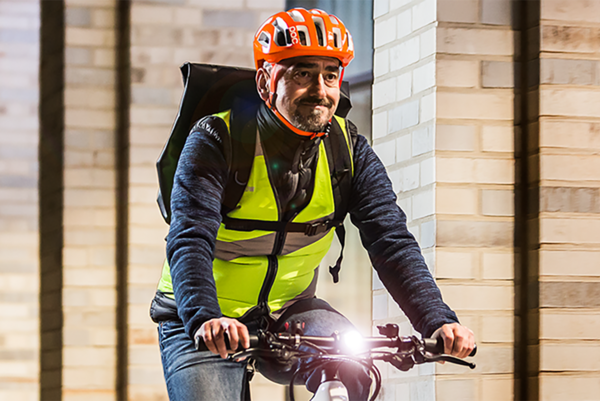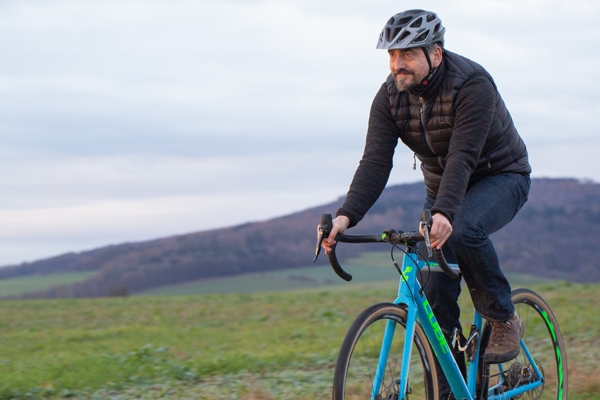
The road bike: none is swifter
Share blog article:
On your mark, get set, go! Today it’s all about speed, or more precisely about the fastest of all bikes, the racing bike, or road race bike. You won’t find any with thick tires and lots of tread. Instead, everything about this bike shouts our: “I will let you pass everyone!”
Are you addicted to speed and do you love to accelerate on flat surfaces? Then a road bike is just the thing for you. Due to its thin tires, it may not be designed for off-road forte, but it defies every incline.
Today’s racing bikes usually weigh as little as 7 to 9 kilograms. However, if you want to take part in official competitions with your racing bike, you have to keep to a minimum weight of 6.8 kilograms. Before this regulation, the lightest racing bike ever used in a UCI (Union Cycliste Internationale) race was Eddy Merckx’s “time trial machine,” with which he set an hour world record in 1972. The track bike weighed only 5.75 kilos.
What makes a “racing machine” and what should you look for when buying?
“Frilly add-ons" such as luggage racks, mudguards or lighting are rarely found on a racing bike. The lightweight design, aerodynamics and the absolute reduction to the parts necessary for riding help attain particularly high speeds.
At first glance, a road bike is usually recognized by its characteristic bow handlebars, which resemble the horns of a goat; that’s why some folks call them “horn handlebars.” There is a sound technical for this distinctive appearance reason: It allows the rider three different grip positions:
- The upper handlebar position is the most upright of the possible riding positions. Disadvantage: Direct access to the brake and gearshift is impaired. When riding in a group, this can increase the risk of accidents.
- If you grip the handlebar from above with your hands on the brake grips, you adopt the flatter brake grip position. The advantage of this grip position is the reduced air drag compared to the top handlebar position.
- The third and last position might seem uncomfortable to a beginner at first. In the lower handlebar position, the cyclist grips directly into the handlebar arch. This position means that the cyclist’s upper body is even more inclined than in the brake handle position, thus achieving even better aerodynamics. Other advantages include the perfect position of the hands to the brake handles and an even lower center of gravity. This specifically enables sprinters to attain more effective power transmission and power development while accelerating and riding at top speed.
The width of the handlebar is based on the shoulder width. The frame size, on the other hand, is measured by the inside leg length.
Did you know? Despite their slim design, the narrowest street in the world is too narrow even for racing bikes. Spreuerhofstraße in the south German city of Reutlingen is just 31 centimeters – just over one foot – wide at its narrowest point.
Disk or rim brake?
As a rule, racing bikes are fitted with derailleur gears. Today’s professional racing bikes with 2 × 11 or 2 × 12 gears, older racing bikes or leisure bikes are also equipped with three chain wheels in the front and 8 to 10 sprockets in the rear.
Disk brakes were initially not widely accepted in road racing – in contrast to mountain biking and cross-country racing. This changed, however, when manufacturers added more racing bike models with disk brakes in their range a few years ago. However, these were met with a degree of reluctance by racing bike enthusiasts.
The reasons for this reluctance included the higher weight and the risk of injury from the sharp edges of brake disks in the event of a fall. Gradually, however, the models with disk brakes prevail among cyclists because they deliver a consistent braking effect in any weather conditions.
Racing bike types: cyclocross bike, track bike and time machine
Racing bikes come in various shapes and designs – for any occasion, competition or surface. Although these variants are very similar to the traditional racing bike in appearance, they are neither suitable nor approved for classic bike races or everyday use. Track bikes, for instance, do not even have a brake.
On the other hand, the cyclocross (cross-country bike, also known as crosser) is considered a true all-rounder. This robust type of race bike with more voluminous and treaded tires and mounting options for mudguards and luggage is designed for everyday use and travel. Suitable for just about any surface, gravel bikes are another variation of race or road bikes.
The main difference between a cyclocross bike and a gravel bike is in the tire width. According to UCI regulations, a cyclocross bike is suitable for competition if its maximum tire width is 33 millimeters. On a gravel bike, that would be the minimum tire width, and it extends up to 50 mm.
With 35,000 participants, the Cape Town Cycle Tour is, incidentally, the world's largest cycling event for everyone. Who knows, maybe you will soon be competing for the title on your new dream bike from Bikeleasing?
Do you have your eye on a new bicycle or e-bike, but you’re not sure which type of bike is the right one for you? No problem! We will support you with practical tips on bike selection and ask you the right questions to make the decision easier. Our leasing model for employees helps you purchase your dream bike. You can save up to 40% off the purchase price when acquiring a bike.



